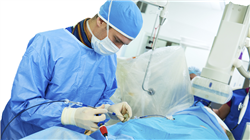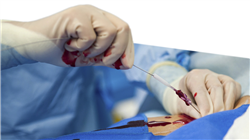University certificate
The world's largest faculty of medicine”
Introduction to the Program
Thanks to this 100% online Professional master’s degree, you will master the latest technologies in Vascular Interventional Procedures and you will carry out the most efficient treatments”

The area of Vascular Interventional Procedures has undergone significant transformations due to the advancement of medical technology, driven by Industry 4.0. Examples of this are angioplasties, embolization techniques and stenting. In this way, minimally invasive procedures are completely revolutionizing the approach to vascular diseases. Among the main advantages of these methods are their ability to reduce the risk of postoperative complications (such as infections or excessive bleeding), minimize recovery time and reduce damage to healthy tissues surrounding the treatment area.
Within this framework, TECH has developed an exclusive and innovative Professional master’s degree in Vascular Interventional Procedures. Its main objective is to bring medical personnel closer to recent advances in endovascular technology, highlighting imaging techniques. The academic itinerary will delve into the handling of instruments such as Ultrasound, Computed Tomography or Magnetic Resonance Imaging, which will allow graduates to make more accurate diagnoses. Likewise, the syllabus will deepen in sophisticated techniques of Angioplasty such as the use of the Balloon or Stent. The program will also offer the keys to perform an optimal approach in common conditions, ranging from Peripheral Artery Disease or Aneurysms to Embolic Occlusion. Thanks to this, specialists will develop clinical competences to perform rigorous diagnoses and perform vascular interventions with maximum effectiveness.
In addition, TECH employs a 100% online methodology, where didactic strategies such as the Relearning method stand out, based on the repetition of key concepts to fix knowledge and facilitate the updating of competencies. All doctors will need is an electronic device with Internet access to access the Virtual Campus and enjoy the most dynamic didactic materials on the educational market. In addition, they will find a variety of resources in a variety of formats such as interactive summaries or specialized readings. Undoubtedly, a program based on the latest scientific postulates in Vascular Interventional Procedures that will significantly optimize the work of physicians.
If you have set yourself the goal of renewing your knowledge, TECH gives you the opportunity to achieve it while combining it with your professional responsibilities”
This Professional master’s degree in Vascular Interventional Procedures contains the most complete and up-to-date scientific program on the market. The most important features include:
- The development of case studies presented by experts in Angiology and Vascular Surgery
- The graphic, schematic and eminently practical contents with which it is conceived gather scientific and practical information on those disciplines that are indispensable for professional practice
- Practical exercises where self-assessment can be used to improve learning.
- Its special emphasis on innovative methodologies
- Theoretical lessons, questions to the expert, debate forums on controversial topics, and individual reflection assignments
- Content that is accessible from any fixed or portable device with an Internet connection
You will delve into the most sophisticated Multimodal Imaging Techniques, which will allow you to obtain detailed information about the structure and function of the body's organs”
The program’s teaching staff includes professionals from the field who contribute their work experience to this educational program, as well as renowned specialists from leading societies and prestigious universities.
The multimedia content, developed with the latest educational technology, will provide the professional with situated and contextual learning, i.e., a simulated environment that will provide immersive education programmed to learn in real situations.
This program is designed around Problem-Based Learning, whereby the professional must try to solve the different professional practice situations that arise during the course. For this purpose, students will be assisted by an innovative interactive video system created by renowned and experienced experts.
You will perfect your therapeutic procedures through innovative strategies of Endovascular Treatment, with which you will prevent the management of complications such as internal bleeding"

TECH's characteristic Relearning system will allow you to renew your knowledge at your own pace and without depending on external teaching conditions"
Why study at TECH?
TECH is the world’s largest online university. With an impressive catalog of more than 14,000 university programs available in 11 languages, it is positioned as a leader in employability, with a 99% job placement rate. In addition, it relies on an enormous faculty of more than 6,000 professors of the highest international renown.

Study at the world's largest online university and guarantee your professional success. The future starts at TECH”
The world’s best online university according to FORBES
The prestigious Forbes magazine, specialized in business and finance, has highlighted TECH as “the world's best online university” This is what they have recently stated in an article in their digital edition in which they echo the success story of this institution, “thanks to the academic offer it provides, the selection of its teaching staff, and an innovative learning method aimed at educating the professionals of the future”
A revolutionary study method, a cutting-edge faculty and a practical focus: the key to TECH's success.
The most complete study plans on the university scene
TECH offers the most complete study plans on the university scene, with syllabuses that cover fundamental concepts and, at the same time, the main scientific advances in their specific scientific areas. In addition, these programs are continuously being updated to guarantee students the academic vanguard and the most in-demand professional skills. In this way, the university's qualifications provide its graduates with a significant advantage to propel their careers to success.
TECH offers the most comprehensive and intensive study plans on the current university scene.
A world-class teaching staff
TECH's teaching staff is made up of more than 6,000 professors with the highest international recognition. Professors, researchers and top executives of multinational companies, including Isaiah Covington, performance coach of the Boston Celtics; Magda Romanska, principal investigator at Harvard MetaLAB; Ignacio Wistumba, chairman of the department of translational molecular pathology at MD Anderson Cancer Center; and D.W. Pine, creative director of TIME magazine, among others.
Internationally renowned experts, specialized in different branches of Health, Technology, Communication and Business, form part of the TECH faculty.
A unique learning method
TECH is the first university to use Relearning in all its programs. It is the best online learning methodology, accredited with international teaching quality certifications, provided by prestigious educational agencies. In addition, this disruptive educational model is complemented with the “Case Method”, thereby setting up a unique online teaching strategy. Innovative teaching resources are also implemented, including detailed videos, infographics and interactive summaries.
TECH combines Relearning and the Case Method in all its university programs to guarantee excellent theoretical and practical learning, studying whenever and wherever you want.
The world's largest online university
TECH is the world’s largest online university. We are the largest educational institution, with the best and widest online educational catalog, one hundred percent online and covering the vast majority of areas of knowledge. We offer a large selection of our own degrees and accredited online undergraduate and postgraduate degrees. In total, more than 14,000 university degrees, in eleven different languages, make us the largest educational largest in the world.
TECH has the world's most extensive catalog of academic and official programs, available in more than 11 languages.
Google Premier Partner
The American technology giant has awarded TECH the Google Google Premier Partner badge. This award, which is only available to 3% of the world's companies, highlights the efficient, flexible and tailored experience that this university provides to students. The recognition as a Google Premier Partner not only accredits the maximum rigor, performance and investment in TECH's digital infrastructures, but also places this university as one of the world's leading technology companies.
Google has positioned TECH in the top 3% of the world's most important technology companies by awarding it its Google Premier Partner badge.
The official online university of the NBA
TECH is the official online university of the NBA. Thanks to our agreement with the biggest league in basketball, we offer our students exclusive university programs, as well as a wide variety of educational resources focused on the business of the league and other areas of the sports industry. Each program is made up of a uniquely designed syllabus and features exceptional guest hosts: professionals with a distinguished sports background who will offer their expertise on the most relevant topics.
TECH has been selected by the NBA, the world's top basketball league, as its official online university.
The top-rated university by its students
Students have positioned TECH as the world's top-rated university on the main review websites, with a highest rating of 4.9 out of 5, obtained from more than 1,000 reviews. These results consolidate TECH as the benchmark university institution at an international level, reflecting the excellence and positive impact of its educational model.” reflecting the excellence and positive impact of its educational model.”
TECH is the world’s top-rated university by its students.
Leaders in employability
TECH has managed to become the leading university in employability. 99% of its students obtain jobs in the academic field they have studied, within one year of completing any of the university's programs. A similar number achieve immediate career enhancement. All this thanks to a study methodology that bases its effectiveness on the acquisition of practical skills, which are absolutely necessary for professional development.
99% of TECH graduates find a job within a year of completing their studies.
Professional Master's Degree in Vascular Interventional Procedures
In a world where medicine is advancing by leaps and bounds, specialization is becoming increasingly crucial. If you are looking to become an expert in the field of vascular interventional medicine, this Professional Master's degree offered by TECH Global University of Technology is your gateway to a future full of professional opportunities and achievements. As an industry leader, we are proud to offer a comprehensive program that seamlessly blends theory and practice, all in a virtual environment accessible from anywhere in the world. With our online classes, taught by leaders in the field of vascular interventionalism, you'll have the flexibility to study at your own pace while immersing yourself in the deeper aspects of this fascinating discipline. Get ready to explore in detail a variety of topics, from the fundamentals of vascular anatomy to the most advanced interventional techniques. Throughout the program, you'll dive into the world of angioplasty, embolization, vascular stenting, thrombectomy and more, all backed by the latest technology and most up-to-date knowledge available in the field.
Leading the field of vascular medicine
One of the highlights of our program is the opportunity to participate in virtual hands-on experiences. Through simulated clinical cases and immersive multimedia content, you'll be able to apply your theoretical knowledge, hone your technical skills and develop the confidence to meet real-world challenges. By completing our rigorous program, you'll be prepared to meet the challenges and seize the opportunities in the field of vascular interventionalism. Whether you want to advance your current career, explore new job opportunities or contribute to the advancement of vascular medicine, this Professional Master's degree offered by TECH Global University of Technology will provide you with the tools and knowledge necessary to achieve your goals. Take advantage of this unique opportunity to advance your career in vascular medicine by enrolling in the Professional Master's Degree of Science in Vascular Interventional Medicine today and begin your journey to an exceptional medical career!







